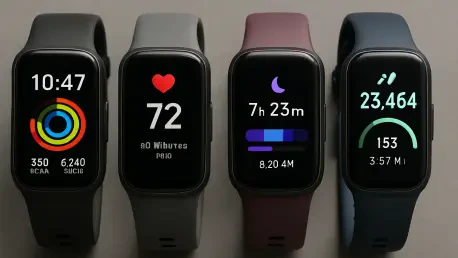In today’s fast-paced world, wearable technology has become a cornerstone for millions seeking to enhance their health, productivity, and connectivity, with smartwatches and fitness bands emerging as the most popular choices among consumers looking for practical solutions. These devices, while sharing some similarities, cater to vastly different needs and lifestyles, making the decision between them a significant one for potential buyers. Fitness bands are often seen as dedicated tools for tracking physical activity and wellness metrics, offering a focused experience for those prioritizing health. Smartwatches, by contrast, position themselves as multifaceted gadgets, blending fitness features with smartphone-like capabilities to keep users connected on the go. With an ever-growing market flooded with options, the challenge lies in determining which device provides the most bang for the buck based on individual preferences, daily routines, and financial considerations. This analysis aims to dissect the core differences between these two wearables, exploring their functionality, practicality, design, and overall appeal to help guide consumers toward a choice that aligns with their unique goals. Whether the aim is to monitor every step during a marathon training session or to seamlessly manage notifications during a busy workday, understanding the strengths and limitations of each device is key to making an informed decision.
Core Purpose and Functionality
The primary distinction between fitness bands and smartwatches lies in their intended purpose, which shapes their functionality and target audience. Fitness bands are engineered with a laser focus on health and activity tracking, delivering precise measurements of essentials like step counts, heart rate, and sleep quality. These devices cater to individuals who prioritize wellness, whether they’re casual walkers aiming to hit daily goals or dedicated athletes monitoring performance metrics. The simplicity of fitness bands ensures that users aren’t bogged down by extraneous features, allowing for a streamlined experience that emphasizes consistent data collection. This makes them particularly appealing to those who want a no-frills approach to maintaining or improving their physical well-being without distractions from other digital functionalities.
Smartwatches, conversely, are designed to serve as comprehensive tools that extend beyond fitness tracking to encompass a wide array of digital interactions. These wearables often mimic smartphone capabilities, enabling users to make calls, reply to messages, access third-party apps, and even make contactless payments directly from their wrist. While they do incorporate health tracking features similar to fitness bands, their broader scope means they appeal to tech-savvy individuals or professionals who value staying connected without constantly reaching for their phone. However, this versatility can sometimes dilute the focus on fitness, as the multitude of features may overwhelm users who primarily seek health insights. The trade-off between specialization and multifunctionality becomes a critical factor in assessing which device offers superior value for specific needs.
Practicality and Battery Performance
When evaluating practicality, fitness bands often stand out due to their impressive battery endurance and ease of use in everyday scenarios. Many models can operate for a week or longer on a single charge, making them ideal for continuous wear, whether during sleep tracking or extended workout sessions. This longevity eliminates the need for frequent charging, a significant advantage for users who lead active lifestyles or travel often and may not always have access to a charger. Additionally, the lightweight construction of fitness bands ensures they remain comfortable even after hours of wear, avoiding the bulkiness that can sometimes accompany more feature-heavy devices. For those who value a low-maintenance wearable that seamlessly integrates into their routine, this aspect of fitness bands often tips the scales in their favor.
Smartwatches, while packed with innovative features, frequently fall short in the battery department, largely due to their power-intensive components like high-resolution screens and constant connectivity. Most models require charging every one to two days, which can be inconvenient for users who forget to plug in overnight or who rely on their device for uninterrupted tracking. This frequent need for recharging may disrupt the user experience, particularly for those who depend on consistent health data or who use their wearable during multi-day outings. Although smartwatches offer a broader range of capabilities, the trade-off in terms of maintenance can be a notable drawback, especially for individuals seeking a hassle-free option that doesn’t demand regular attention to power levels.
Design and Aesthetic Appeal
The design of wearable tech plays a pivotal role in how well it integrates into a user’s lifestyle, and smartwatches often take the lead in terms of aesthetic versatility. Crafted with premium materials like stainless steel or ceramic, many smartwatches double as fashion accessories, offering customizable watch faces and interchangeable bands to match casual or formal attire. This adaptability makes them a popular choice for individuals who want a device that not only functions well but also enhances their personal style. Whether worn to a business meeting or a weekend outing, smartwatches are designed to make a statement, appealing to those who see their wearable as an extension of their identity rather than just a tool for tracking or connectivity.
Fitness bands, in contrast, prioritize functionality over visual appeal, often adopting a minimalist approach that focuses on comfort and durability. Typically made with lightweight, sweat-resistant materials like silicone, these devices are built to withstand the rigors of physical activity without drawing attention. Their unobtrusive design ensures they can be worn discreetly under clothing or during sleep, catering to users who prefer a wearable that blends into their daily routine rather than standing out. While lacking the flair of smartwatches, fitness bands excel in practicality, making them a preferred option for those who value ease of wear during intense workouts or long hours of activity over a polished, eye-catching appearance.
Weighing Costs and Accessibility
Price is often a decisive factor when choosing between these two types of wearables, and fitness bands generally offer a more budget-friendly entry point into the world of health tracking. With many models available at a fraction of the cost of high-end smartwatches, they provide essential features like step counting and heart rate monitoring without breaking the bank. This affordability makes fitness bands an attractive option for beginners exploring wearable tech or for individuals who are mindful of spending but still want reliable data to support their wellness journey. The lower financial commitment also reduces the risk for those unsure about how often they’ll use such a device, allowing them to test the waters without a significant investment.
Smartwatches, particularly those from leading brands, often come with a steeper price tag due to their advanced hardware, extensive feature sets, and premium designs. The cost reflects not only the technology packed into the device but also the integration with broader digital ecosystems, such as compatibility with specific smartphones or services. For users who need or desire the full spectrum of connectivity and functionality—ranging from app access to advanced health sensors—this higher expense may be justified. However, for those who don’t require such comprehensive capabilities, the elevated price can feel disproportionate to the value gained. Balancing the desire for cutting-edge features against budgetary constraints becomes a key consideration in determining which wearable ultimately delivers the most worth.
Final Reflections on Choosing Wisely
Looking back, the comparison between smartwatches and fitness bands reveals a nuanced landscape where neither device emerges as the definitive winner, but rather each excels in distinct areas based on user needs. Fitness bands prove their worth for those who seek dedicated health tracking, offering impressive battery life and affordability that make them a reliable companion for wellness-focused individuals. Smartwatches, with their expansive connectivity and stylish designs, carve out a niche for users who value a seamless blend of technology and lifestyle, despite the higher costs and maintenance demands. The decision ultimately hinges on personal priorities, whether rooted in deep fitness insights or broader digital integration. Moving forward, consumers are encouraged to pinpoint their primary goals—be it uninterrupted activity monitoring or staying plugged into a digital ecosystem—and align their choice accordingly. As the wearable tech market continues to innovate, staying informed about emerging hybrid options and advancements in health sensors could further refine this decision, ensuring the selected device not only meets current needs but also adapts to future possibilities.









